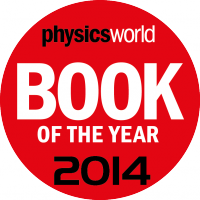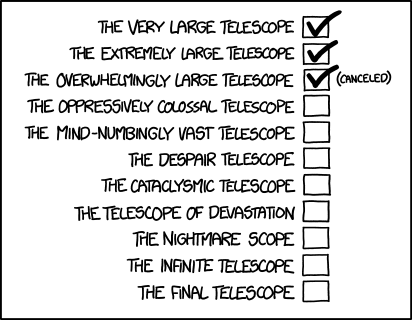Tag archives: book reviews
Physics World‘s shortlist for Book of the Year 2016
 By Margaret Harris and Tushna Commissariat
By Margaret Harris and Tushna Commissariat
The year 2016 has not covered itself in glory. Divisive elections, various natural and human-made disasters and a depressingly long obituary roll of well-loved celebrities mean that for many residents of planet Earth, this solar orbit has been one to forget.
But if, for a moment, we concentrate solely on the year in physics, the picture looks brighter. In particular, it’s been another strong year for popular-physics writing, and over the past few weeks, we have been determining which of the 57 books reviewed in Physics World in 2016 deserve to be on our list of the year’s best.
The books that appear on the shortlist below are all well written, novel and scientifically interesting to physicists – the criteria we’ve followed since 2009, when The Strangest Man, Graham Farmelo’s landmark biography of Paul Dirac, became our first “Book of the Year”. A couple of biographies appear on our 2016 shortlist, too, but they face stiff competition from books on big science, stringy science, loopy science, spooky science, jazzy science and more. There’s even a book of science infographics in the running – a first for a competition that is, naturally, dominated by words rather than images.
We’ll announce the winner of our “Book of the Year” award in the Physics World podcast in mid-December, but in the meantime, take a look at the shortlist. We think it’s proof, if you needed any, that the year 2016 had some redeeming features after all.
View all posts by this author | View this author's profile
From penguins to photons – the December 2016 issue of Physics World is now out
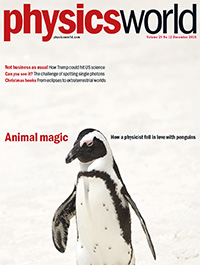 By Matin Durrani
By Matin Durrani
Everyone loves physics. And everyone loves animals, right? In the December issue of Physics World magazine, which is now live in the Physics World app for mobile and desktop, University of Bristol physicist Peter Barham explains how he became an expert in penguins, studying the factors that that affect their survival and discovering how to use the spots on African penguins to identify them. You can also read the article here.
Elsewhere in the new issue, you can enjoy our selection of the best books for Christmas, discover how one physicist became a successful contemporary dancer, and find out how to spot single photons with your naked eye.
Don’t miss either the chance to win a copy of Astronomy Photographer of the Year: Collection 5 in our special prize puzzle.
View all posts by this author | View this author's profile
The December 2015 issue of Physics World is out now
By Matin Durrani
As the festive season approaches, many of you will be looking forward to popping open a bottle of champagne. But before you treat yourself to a bottle, do check out the December 2015 issue of Physics World magazine, in which fizzy-wine physicist Gérard Liger-Belair from the University of Reims Champagne-Ardenne reveals his top six champagne secrets.
In the article, Liger-Belair explains why a fog appears when you pop open a bottle, the angle at which you should pour the wine into a glass, and how many bubbles there are in a typical glass of fizz. He also wades into that age-old question among sparkling-wine aficionados: flute or coupe?
The new issue also contains a fabulous flow chart, in which you can find out what sort of scientist you are. Don’t miss either our look back at the International Year of Light, a fantastic selection of Christmas books and a feature all about how origami is moving from art to application.
If you’re a member of the Institute of Physics (IOP), you can get immediate access to this article in the award-winning digital edition of the magazine on your desktop via MyIOP.org or on any iOS or Android smartphone or tablet via the Physics World app, available from the App Store and Google Play. If you’re not yet in the IOP, you can join as an IOPiMember for just £15, €20 or $25 a year to get full digital access to Physics World. You can also read Liger-Belair’s article online here.
Chocolate dynamics, recycling urine, the hipster-physicist look and more

Cocoa conch: a chocolate’s distinctive flavour and texture comes from “conching”. (Courtesy: iStock/deyangeorgiev)
By Michael Banks, Tushna Commissariat and Matin Durrani
Chocolate, the food of the gods, is more popular now as a sweet treat than ever before. And while more and more people know their 70% cocoa from their truffles, “lecithin” still isn’t a word that pops up often. It is an ingredient that plays a key role in chocolate-making and other foods. But this fatty substance has long confounded food-scientists and confectioners alike – we don’t know how this ingredient works on a molecular level and confectioners have had to rely on observations and trial-and-error methods to perfect recipes.
Now, though, chocolatiers have had help from an unexpected field – that of molecular biology – to figure out chocolate “conching” – the part of the chocolate-making process where aromatic sensation, texture and “mouthfeel” are developed. In a special issue on “The Physics of Food” published in the Journal of Physics D: Applied Physics, Heiko Briesen and colleagues at Technische Universität München, Germany, use molecular dynamics to model and simulate how lecithin molecules, made from different sources, attach to the sugar surface in cocoa butter. “I’m quite confident molecular dynamics will strongly support food science in the future” says Briesen.
View all posts by this author | View this author's profile
Top physics books for 2014
Is it time for end-of-the-year lists already? At Physics World HQ, the answer is a definite “yes”, and we’re kicking off the season with our annual list of the year’s best physics books.
As in previous years, the entries on our “Book of the Year” shortlist are all well written, novel and scientifically interesting for a physics audience. They represent the best of the 57 books that Physics World reviewed in 2014, being highly commended by external experts (the diverse group of professional physicists and freelance science writers who review books for the magazine) and by members of our own editorial staff, who helped winnow the field down to a shortlist of 10.
This is the sixth year we’ve picked a “Book of the Year”, and I don’t think I’ve ever seen a stronger shortlist. Frankly, 2014 has been a fantastic year for science books, and for physics books in particular. You’ll see that quality reflected in the list below, where first-person accounts of the latest discoveries rub shoulders with historical analyses of the foundations of the field. There’s room in our shortlist for books about acoustic physics, exoplanets, geophysics, materials science, radiation safety and scientific ethics – plus a whimsical tour of the physics of fantasy and science fiction.
View all posts by this author | View this author's profile
Golden-anniversary physics, flaming challenges, smart lists and more

How do you explain the science behind a rainbow to a child?
By Tushna Commissariat
It never rains but it pours, they say, and 1964 experienced quite a downpour of amazing “physics firsts” as the first papers about quarks, the Higgs mechanism and the EPR paradox or Bell’s inequality were all published. Also, Arno Penzias and Robert Woodrow Wilson made their first measurement of the cosmic microwave background on 20 May 1964, detecting the whisper of the Big Bang. To celebrate 50 years since these world-changing discoveries were made, the Harvard-Smithsonian Centre for Astrophysics has produced a webcast (you can watch the video on their YouTube page in a week’s time) featuring leading cosmologists Alan Guth, Robert Woodrow Wilson, Robert Kirshner and Avi Loeb. You can read more about it in this fascinating article by David Kaiser on the Huffington Post website, as he take a deeper look at the eventful year of 1964.
Cress on the Moon, more physics books, a radioactive ‘foot’ and more
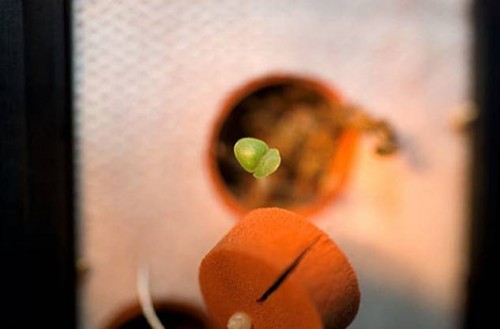
A small green sprout of cinnamon basil, growing on board the International Space Station in 2007. (Courtesy: NASA)
By Tushna Commissariat
Early this week, a story in the Telegraph caught our eye – NASA is planning on sending turnip, cress and basil seeds to the Moon to germinate them! This is most definitely not the first time that plants have been grown beyond the realms of Earth. Indeed, potatoes were grown on board during a 1995 Space Shuttle mission and many experiments involving germinating seeds were done on the International Space Station. The goal of these studies was to understand the effects of microgravity on plant growth. But now, NASA plans to take this one step further in 2015 with their Moon Express mission, which will include the Lunar Plant Growth Chamber that will carry seeds and enough air and nutrients to allow the seeds to sprout and grow. Will fresh salad be on an astronaut’s menu soon?
Pop-culture mathematics
By Tushna Commissariat
Earlier this week I went to hear a talk about mathematics…and The Simpsons. That’s right, I am indeed referring to the long-running animated TV show that is a satirical parody of middle-class American life and its unexpected but concrete mathematical vein. Surprising as it may sound, some of show’s scriptwriters have degrees in maths and physics, meaning that some very advanced concepts, problems and ideas from all of 20th-century mathematics and physics are littered around many of the show’s 535 episodes. Regular Physics World readers will have already seen that we have released the shortlist for our Book of the Year 2013 and that physicist and science communicator Simon Singh’s latest offering – The Simpsons and their Mathematical Secrets – is one of 10 books on the list. I had the happy job of reading and reviewing Singh’s book for our “Between the lines: Christmas special” section in the December issue of the magazine.
View all posts by this author | View this author's profile
Book of the Year shortlist for 2013
By Margaret Harris
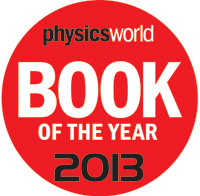
As the year draws to a close, it’s time for Physics World to dig into its cabinet full of popular-physics volumes, pore over the reviews and decide which of the 59 books we covered in 2013 deserves to be our pick for the year’s best.
As we did last year, we’ve begun by selecting a shortlist of the 10 books that most closely meet our award criteria, which are that the winning book must be novel, scientifically interesting and (of course) well written. This required us to make some tough choices: although many books fulfilled two of our requirements, fewer could claim high marks in all three areas.
The books on the 2013 shortlist are an eclectic group, reflecting the “big tent” nature of physics in recent times. They include popular-science works on biophysics, bombs and a seriously important boson, plus vivid biographies of two very different figures from the history of physics. And we are fairly certain that ours is the only “best books” list you’ll ever see that pits a scholarly argument about the nature of time up against a fan-friendly look at mathematics in the animated TV show The Simpsons.
View all posts by this author | View this author's profile
Safe graphene, Martian mollycoddling, mathematical tales and more
By Tushna Commissariat
Just when we thought that it couldn’t possibly have any more practical applications, everybody’s favourite “wonder material” graphene is going to be used to develop “stronger, safer, and more desirable condoms”. Thanks to a Grand Challenges Explorations grant of £62,123 from the Bill and Melinda Gates Foundation, scientists at the University of Manchester will use graphene to develop new “composite nanomaterials for next-generation condoms, containing graphene”. Unsurprisingly, the story made all the national newspapers with the BBC, the Guardian, the Telegraph and the Independent all having their say. The Guardian also noted that industrial graphene-producer Applied Graphene Materials’ shares jumped by 40% during its stock-market debut, the day before the above story broke. You can read more about graphene’s many potential applications on page 50 of Physics World’s anniversary issue, a free PDF download of which is available here.
View all posts by this author | View this author's profile
